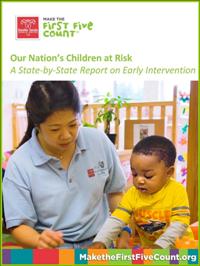Articles, Reports, Fact Sheets & Story Ideas
Access the most recent reports, including the Our Nation’s Children At Risk: A State-by-State Report of Early Intervention, as well as fact sheets and story ideas to build your early childhood stories and learn all about early identification, early treatment and early intervention. Through each, you'll find helpful tips and tools to share with parents about their child's development and how to get help.
White Paper

Our Nation’s Children At Risk: A State-by-State Report on Early Intervention
 |
|
In the News
 |
Parents Magazine |
Fact Sheets
Click on the link to download PDF copies of Make The First Five Count fact sheets.
- Facts & Figures* (PDF)
- Five by Five: a Parent's 5 Minute Guide to 5 Areas of Development* (PDF)
- Warning Signs to Watch For* (PDF)
Story Ideas
Here are a few ideas to get your creative Make The First Five Count juices flowing. We'd love to work with you on developing national or local stories, introduce you to our experts and families or schedule a visit to a program.
- Focus on "5"
Consider approaching your local 'channel 5' station first (e.g., Chicago's local NBC affiliate). We want people to focus on the first five years of life. That said, we can propose to media a weekly series (Monday – Friday) to help launch the new Make the First Five Count program during which each day would highlight a specific year in life. For each year, we could share the social and developmental milestones and even demonstrate what early intervention services look like and how they change as kids grow and progress. - Local Representative
Create a mini media event. Invite your local and state representatives to your center to help launch the Make the First Five Count program and see first-hand the programs that would benefit from additional funding for early intervention services. You can pitch his/her office a request for a brief visit from the representative to help launch the national Easter Seals Make the First Five Count program to show their support and commitment to young children and early intervention services. - Funding Cuts
Give media a local perspective by introducing them to a local family or two so they can put a face to the issue at hand. Provide examples, if possible, of how budget cuts have affected the number of children you’re able to provide services to, etc. And show how with increased federal and state funding, your center would be able to do so much more. - Easter Seals Influence
Explain how Easter Seals has proven they can make an impact on lives of families living with disabilities. That’s why we’re focusing our efforts on the importance of early intervention services and the funding needed to make the services available to as many children and families as possible – as early as possible. For example, through the existence of Easter Seals Child Development Centers, open to children with and without disabilities, Easter Seals has seen many cases in which parents weren’t aware of any issues and learned of them only through their child being enrolled in the Center. Easter Seals has also developed a set of evidence-based and user-friendly training tools to increase the effective inclusion of young children with disabilities in child care, Head Start and Early Head Start, preschool, and other early childhood settings. - Capitalize on Local Election, Political Coverage
Monitor local election media coverage pertaining to education reform or reporters who cover the education beat. You’ll probably notice the focus starts with Kindergarten. This gives us a good entrée to talk about Make the First Five Count and how the focus of education reform needs to begin with the years leading up to Kindergarten – well before age five. - Public Service Announcements (PSA)
Research your local media requirements for receiving PSAs. For example, some radio stations will accept emails or faxed documents with a brief description about Make the First Five Count and our call to action to visit MaketheFirstFiveCount.org to sign the petition to help make a difference for young children.
*This document is in the Adobe PDF format. If you do not have Acrobat Reader, you can download free Adobe Acrobat Reader software (link will open in new window) to view this document.
